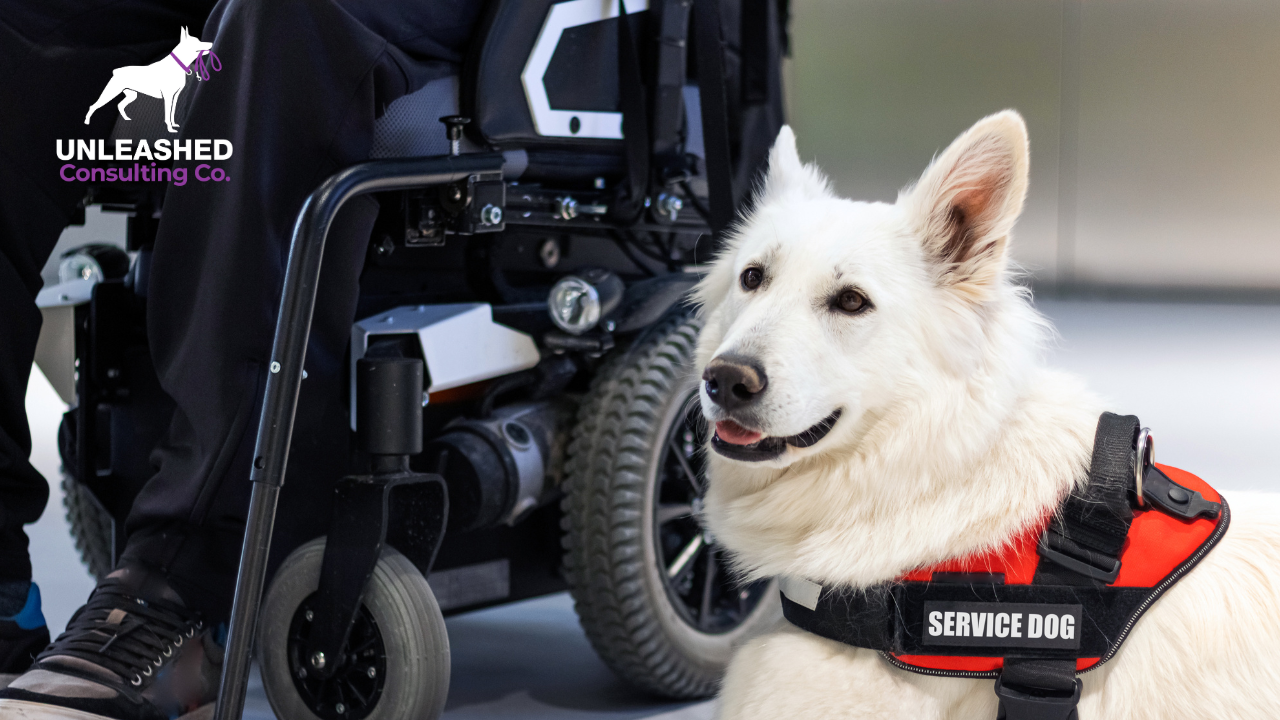Are you a service dog trainer looking to expand your reach and connect with more clients? Service dog training plays an important role in helping individuals with disabilities live more independent and fulfilling lives.
As the demand for service dogs continues to grow, so does the need for skilled trainers who can ensure these dogs are properly trained and matched with their owners. However, many trainers may struggle to attract new clients and stand out in a competitive market. This is where effective marketing comes into play.
By using the right marketing strategies, you can effectively showcase your expertise, educate potential clients about the benefits of service dog training, and ultimately grow your business.
In this article, we will explore 10 actionable marketing strategies specifically tailored for service dog training.
Whether you’re just starting or looking to enhance your existing marketing efforts, these strategies will help you reach more clients and make a positive impact in your community.
Let’s dive in!
10 Marketing Strategies for Service Dog Training
1. Understand Your Target Audience as a Dog Trainer in Your Area
As a dog trainer focusing on service dog training, it’s important to know who needs your services in your local area. By understanding your target audience, you can create marketing messages that truly connect with them. Let’s break it down into simpler terms.
Who Needs Service Dog Training?
- Individuals with Disabilities: Many people with physical or mental disabilities can benefit from service dogs. For example, someone who has trouble walking might need a dog to help them navigate daily tasks, while someone with anxiety or PTSD may require a dog for emotional support.
- Families with Special Needs Children: Families with children who have autism or other developmental disorders often seek service dogs to help their children feel more comfortable in social situations. These dogs can provide companionship and assist with communication, making daily life easier.
- Veterans: Many veterans return from military service with physical injuries or mental health challenges. Service dogs can provide comfort, companionship, and practical help, making a significant difference in their lives.
- Elderly Individuals: Older adults may also benefit from service dogs, particularly those with mobility issues or cognitive decline. These dogs can help them with daily tasks and provide emotional support.
2. Develop a Guide Website about Service Dog Training
Having a well-designed website is important for any service dog trainer. It serves as your online home where potential clients can learn about your services and how you can help them. Let’s explore the key components of a service dog training website, why design matters, and how to create valuable content for your audience.
Key Components of a Service Dog Training Website
a. Services Offered:
Clearly list all the services you provide. This could include training for various types of service dogs (like mobility assistance, emotional support, or medical alert dogs).
Include detailed descriptions for each service, explaining what clients can expect and how their dogs will benefit from the training. This helps potential clients understand your expertise and how you can meet their specific needs.
b. Testimonials:
Showcasing testimonials from past clients can build trust and credibility.
Include stories or quotes from satisfied customers about how your training helped them and their dogs. If possible, add before-and-after pictures or videos to highlight the transformations. These real-life experiences can resonate with potential clients and encourage them to reach out to you.
c. Contact Information:
Make it easy for potential clients to contact you. Include a clear contact page with multiple ways to reach you, such as phone, email, or a contact form.
You might also want to include links to your social media profiles, so people can connect with you there as well. A prompt response to inquiries can also enhance your reputation.
Including a Blog to Share Valuable Content
A blog is a fantastic addition to your service dog training website. It allows you to share valuable information and connect with your audience on a deeper level. Here’s why you should consider including a blog:
- Educate Your Audience: Use your blog to write about topics related to service dog training. This could include tips for choosing the right service dog, training techniques, or the benefits of service dogs for specific disabilities. Providing helpful information can position you as an expert in your field.
- Share Success Stories: Highlighting success stories from your clients can be inspiring for potential customers. Share detailed accounts of how service dogs have positively impacted lives, including challenges faced and milestones achieved.
- Improve SEO: Regularly updating your blog with relevant content can help improve your website’s search engine ranking. This means more people can find you when searching for service dog training online. Use keywords related to service dog training to attract more visitors.
- Engage with Your Audience: A blog is a great way to encourage interaction. Invite readers to leave comments or questions, and be sure to respond to them. This engagement can help build a community around your services.
3. Use Social Media Platforms for Service Dog Training Contents
Social media is a powerful tool for service dog trainers. It allows you to connect with potential clients, share valuable information, and build a community around your services. Here’s how you can effectively use social media platforms for your service dog training business.
Identify the Most Effective Platforms
a. Facebook
Facebook is one of the most popular social media platforms, making it a great place to reach a wide audience. You can create a business page where you share updates, events, and articles about service dog training. Additionally, Facebook groups related to dog training and support can help you connect with potential clients and fellow trainers.
b. Instagram
Instagram is a visual platform, which is perfect for showcasing your training sessions and the dogs you work with. You can post photos and videos of training exercises, as well as share cute pictures of the service dogs in action. Using hashtags can help you reach more people who are interested in service dog training.
c. TikTok
TikTok is a growing platform that focuses on short videos. It’s especially popular among younger audiences. You can create fun and informative videos showcasing quick training tips, success stories, or even challenges you face during training. Engaging videos can go viral and attract more attention to your services.
4. Use Search Engine Optimization (SEO) Strategies
Search Engine Optimization (SEO) is important for making sure your service dog training website appears in search engine results when potential clients look for training services.
By using effective SEO strategies, you can attract more visitors to your site and increase your chances of gaining new clients. Let’s break down some key SEO tips and tools that can help you succeed.
Tips for Optimizing Website Content
a. Keywords
Keywords are the specific words or phrases that people type into search engines when looking for information. To optimize your website, research and use relevant keywords related to service dog training throughout your content. For example, phrases like “service dog training near me,” “how to train a service dog,” or “best service dog trainers” can help your site appear in search results.
b. Meta Descriptions
A meta description is a short summary of your webpage that appears in search engine results below the page title. It should be concise and include relevant keywords. For instance, a good meta description for your service dog training page might be, “Learn how to train a service dog with our expert guidance. Offering personalized training sessions for all types of service dogs.”
c. Alt Tags
Alt tags are descriptions added to images on your website. They help search engines understand what the images are about, and they also improve accessibility for people using screen readers. When you add an image to your website, include relevant keywords in the alt tag. For example, if you have a picture of a dog being trained, you might use an alt tag like “service dog training session for mobility assistance.”
5. Create Valuable Content
Creating valuable content is an important part of marketing your service dog training business. It helps educate your audience, establishes you as an expert in your field, and attracts more potential clients. Let’s explore the benefits of blogging about service dog training, the value of downloadable resources, and the importance of sharing your content effectively.
Benefits of Blogging about Service Dog Training
a. Educational Resource:
Blogging allows you to share useful information about service dog training. You can write about various topics, such as training tips, the legal aspects of service dogs, and the emotional benefits of having a service dog.
b. Builds Authority:
Regularly posting blogs positions you as an expert in service dog training. When people see that you have in-depth knowledge about the subject, they are more likely to trust you with their training needs.
c. Improves SEO:
Blog posts can help improve your website’s search engine ranking. When you include relevant keywords in your posts, it makes it easier for people searching for service dog training information to find your site.
More visitors to your website can lead to higher chances of converting them into clients.
6. Network with Local Organizations
Networking with local organizations can be a powerful way to grow your service dog training business. By building relationships with other groups in your community, you can expand your reach, share resources, and attract more clients. Here’s how you can identify potential partners, create mutually beneficial relationships, and co-host events to increase your visibility.
Identify Potential Partners
a. Veterans’ Organizations:
Many veterans require service dogs to help with disabilities or emotional support after their military service. Partnering with local veterans’ organizations can provide you with access to individuals who may need your services.
Consider connecting with groups that support veterans in your area, such as Veterans Affairs offices, VFW (Veterans of Foreign Wars) posts, or local veterans’ support networks.
b. Disability Advocates:
Organizations that advocate for individuals with disabilities can also be valuable partners. These groups often have connections to people who might benefit from service dogs, and they can help raise awareness about the importance of service dog training.
c. Animal Shelters and Rescue Groups:
Partnering with animal shelters or rescue organizations can be a great way to find potential service dog candidates. Many shelters are eager to promote the idea of training rescue dogs as service animals.
Consider working with local shelters to help train dogs that are suitable for service work, or collaborate on programs that promote the benefits of service dogs.
7. Implement Referral Programs
Referral programs can be a powerful way to grow your service dog training business through word-of-mouth marketing. By encouraging your satisfied clients to share their positive experiences with others, you can reach more potential clients and build a strong community around your services.
Here’s how to implement an effective referral program.
Benefits of Word-of-Mouth Marketing in the Service Dog Community
a. Trust and Credibility:
Word-of-mouth marketing is one of the most trusted forms of advertising. When someone hears about your services from a friend or family member, they are more likely to trust that recommendation compared to traditional advertising.
In the service dog community, where the decision to seek training can be deeply personal, having a trusted referral can significantly influence a potential client’s choice.
b. Higher Conversion Rates:
Referrals typically result in higher conversion rates. People referred by a satisfied client are more likely to become clients themselves because they already have a positive impression of your services.
This means you can spend less time and effort convincing potential clients to choose you, as the recommendation has already established credibility.
c. Building a Strong Community:
When clients refer friends or family members, it helps create a sense of community around your service dog training. This can lead to lasting relationships among clients and between clients and your business, fostering loyalty and ongoing support.
8. Use Email Marketing Campaigns about Service Dog Training
Email marketing is an effective way to keep in touch with your clients and potential clients in the service dog training community.
It allows you to share valuable information, build relationships, and promote your services. Here’s how you can use email marketing campaigns to enhance your service dog training business.
Importance of Building an Email List
a. Direct Communication:
Building an email list enables you to communicate directly with your audience. Unlike social media, where algorithms can limit the reach of your posts, email allows you to reach your subscribers directly in their inboxes.
This direct line of communication ensures that your messages are seen and can lead to more engaged clients.
b. Ongoing Engagement:
An email list provides an opportunity for ongoing engagement with your clients. You can share regular updates about your services, upcoming events, or new training techniques, keeping your audience informed and interested.
Regular communication helps maintain your business in the minds of your clients, making them more likely to return for additional training or recommend you to others.
c. Building Trust:
By providing valuable content consistently through your emails, you can establish trust with your audience. When clients see that you are knowledgeable and willing to share helpful information, they are more likely to consider you their go-to expert for service dog training.
9. Run Targeted Ads
Running targeted ads is an effective way to reach potential clients who are actively looking for service dog training.
With the right strategy, you can attract more people to your services and increase your client base. Here’s how to effectively use Google Ads and social media advertising for your service dog training business.
Effectiveness of Google Ads and Social Media Advertising
a. Immediate Visibility:
Google Ads allows you to display your services at the top of search results when people look for service dog training. This immediate visibility can drive traffic to your website and increase inquiries about your services.
Social media platforms like Facebook and Instagram also provide a space for your ads to reach users while they browse their feeds, making it easy to capture their attention.
b. Targeted Reach:
Both Google Ads and social media advertising enable you to target specific audiences based on their interests, behaviors, and demographics. This means you can focus your advertising efforts on those who are most likely to need service dog training.
For example, you can target individuals searching for service dog-related keywords or those who have shown interest in pet training on social media.
c. Measurable Results:
One of the significant advantages of online advertising is the ability to track your results. You can see how many people viewed your ad, clicked on it, and eventually became clients.
This data allows you to adjust your advertising strategy based on what works best, ensuring you get the most out of your budget.
Targeting Specific Demographics or Geographic Areas
a. Define Your Ideal Client:
Before running ads, take the time to define your ideal client. Consider factors such as age, location, interests, and specific needs related to service dog training.
Knowing your audience will help you create ads that resonate with them and address their unique challenges.
b. Geographic Targeting:
Use geographic targeting to focus your ads on specific areas where you offer training services. This is especially important if you have a local business, as you want to attract clients who can easily access your training.
For example, if you operate in a particular city or region, you can set your ads to only show to people in that area.
c. Demographic Targeting:
Take advantage of demographic targeting options available on platforms like Facebook. You can target your ads based on age, gender, and interests, ensuring they reach the right people.
For instance, if your training services cater to veterans, you might target ads toward individuals in military-related groups or communities.
d. Use of Retargeting:
Implement retargeting ads to reach people who have previously visited your website but didn’t convert. These ads can remind them of your services and encourage them to return.
Retargeting is a powerful way to keep your services top-of-mind and can help convert interested individuals into clients.
10. Collect and Showcase Testimonials
Collecting and showcasing testimonials from your clients is a powerful way to build trust and credibility for your service dog training business. When potential clients see that others have had positive experiences with your services, they are more likely to consider enrolling their dogs in your training programs. Here’s why testimonials matter and how to effectively gather and display them.
Importance of Social Proof in Service Dog Training
a. Building Trust:
Testimonials serve as social proof, which means they show potential clients that others have had successful experiences with your training. This trust is crucial when people are looking for help with something as important as training a service dog.
When someone reads a positive review or testimonial, they feel more confident in choosing your services over competitors.
b. Highlighting Success Stories:
Real-life success stories from your clients can illustrate the effectiveness of your training. These stories can show the transformations that take place when dogs go through your program, making it relatable for potential clients.
Sharing these experiences helps paint a picture of what clients can expect, which can encourage them to take the next step in training their service dogs.
c. Differentiating Your Business:
In a competitive market, testimonials can help set you apart from other trainers. Highlighting the positive experiences of your clients can showcase what makes your services unique and valuable.
Potential clients often look for reasons to choose one service over another, and glowing testimonials can be the deciding factor.
Conclusion
Implementing effective marketing strategies is important for service dog training businesses to connect with clients who need their expertise.
By understanding your target audience, developing a compelling website, utilizing social media, optimizing for search engines, creating valuable content, networking with local organizations, implementing referral programs, using email marketing, running targeted ads, and showcasing testimonials, you can significantly enhance your visibility and client base.
These effective marketing strategies for service dog training not only promote your services but also build trust and credibility within the community, ultimately helping more service dogs and their handlers succeed.
If you’re ready to take your service dog training business to the next level, Unleashed Consulting is here to help!
Our team of experts specializes in developing tailored marketing strategies that resonate with your audience and drive results.
Contact us today to discover how we can partner with you to grow your business and make a positive impact in the lives of those who need your services. Let’s work together to unleash your potential!






